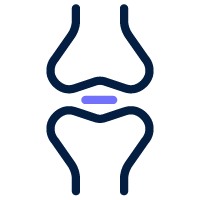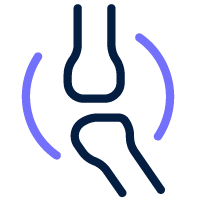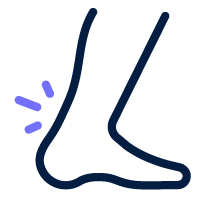Treating osteoarthritis
What is osteoarthritis? How do the different types of osteoarthritis work and how can you prevent, or treat? On this page you will learn all about osteoarthritis.
What you will learn:
What is osteoarthritis?
Osteoarthritis is a common disorder of the joints. It can affect any joint in the body. Usually, it is the joints that bear most of
our weight, such as the knees and hips.
When a joint develops osteoarthritis, some of the cartilage becomes thinner and the surface becomes rougher. This means the joint does not move as smoothly as it should.
Twee soorten artrose
This is the most common form of osteoarthritis and is largely due to "wear and tear" over time. Because of this, it is associated with aging; in fact, age is the main risk factor for osteoarthritis and the longer a person uses their joints, the more likely they are to suffer from this form of osteoarthritis.
People tend to develop this type of osteoarthritis from the age of 55 or 60.
This form of osteoarthritis results from changes in the microenvironment of cartilage. Such changes can be caused by trauma, congenital joint defects, metabolic defects, infections, diseases and conditions that alter the normal structure and function of cartilage (such as rheumatoid arthritis or gout).
Secondary osteoarthritis usually occurs in relatively young individuals of about 45 or 50 years of age.
What are the causes of osteoarthritis?
It is still not clear what causes osteoarthritis. We know that it is not simple "wear and tear" and that other factors influence the individual risk of developing osteoarthritis
.
It is often a combination of several factors that lead to osteoarthritis: age, gender, obesity, joint injuries, genetic factors and joint disorders.
Which joints are affected by osteoarthritis?
Osteoarthritis of the knee is very common. This is probably because your knee must also endure extreme strains, twisting and turning as it bears your body weight. Osteoarthritis can affect the main surfaces of the knee joint or the cartilage under your kneecap. It often affects both knees.
Osteoarthritis of the hip is also common and can affect both or both hips. The hip joint is a ball and socket joint that normally has a wide range of motion. It also bears much of your weight. Osteoarthritis of the hip is equally common in men and women, and usually begins between the ages of 45 and 50.
Osteoarthritis of the hands usually occurs as part of the condition nodal osteoarthritis. It mostly affects women and often begins between the ages of 40 and 50, around the time of menopause. Normally affects the base of your thumb and the joints at the ends of your fingers, although other finger joints may also be affected. Symptoms can come and go, but the pain often stops after several years, leaving joints to work properly.
The bones of your spine and intervertebral discs are often affected by changes that closely resemble osteoarthritis. In the spine, these changes are often called spondylosis. Although they are very common, they are not the most common cause of back or neck pain.
Osteoarthritis of the foot generally affects the joint at the base of your big toe. However, osteoarthritis of the midfoot is also quite common. The ankle is the least frequently affected part of the foot.
The shoulder consists of two joints:
- a ball and socket joint where the upper arm meets the shoulder - this is called the glenohumeral joint and has a very wide range of motion
- a smaller joint where the collarbone meets the top of the shoulder, which has a much smaller range of motion and is called the acromioclavicular
joint.
With osteoarthritis, the acromioclavicular joint is more likely to be affected, but can also affect the glenohumeral joint.
The elbow joint is one of the least commonly affected by: osteoarthritis. When it is affected, it may follow a single serious injury or a number of smaller injuries to the elbow, often as a result of a job in which the
elbow joint is unusually loaded.
The jaw, or temporomandibular joint, is one of the most frequently used joints in the body and the cartilage in this joint is particularly susceptible to wear and tear. Osteoarthritis of the jaw may therefore begin at a younger age than
many other joints.
Prevention is better than cure, how to prevent osteoarthritis?
Strengthening muscle strength stabilizes the knee joint and helps to absorb pressure.
Strengthening usually includes the quadriceps and hamstrings, but it shouldn't end here. Strengthening the hip and core muscles is also essential to maximize knee function.
If you are overweight, each extra kilogram translates into another 4 kg of extra pressure on the joints. Losing weight helps relieve the pressure on your joints and it also improves your overall health.
Not only can obesity increase your risk of developing osteoarthritis, it can also contribute to an increase in inflammatory factors associated with the knees and other joints.
Conclusion: losing a few pounds can significantly reduce the pressure on your knees and protect them from daily wear and tear.
"Range of motion" is the normal amount by which your joints can be moved in certain directions. Everyday activities such as climbing stairs, bending and lifting do not move your joints through their full range of motion.
Are your joints swollen and painful? Then use gentle stretching exercises to increase the range of motion of your knees - possibly enlisting the help of a physical therapist.
Good posture is a basic rule for everyone. Your body is constantly at work keeping itself upright against gravity. Because of this, proper posture is the key to avoiding unnecessary strain on the back, hip and knee joints.
There is no specific diet plan to relieve joint pain, but adding certain nutrients to your diet can help protect your joints.
Studies show that regular consumption of omega-3 fatty acids reduces the inflammation caused by long-term knee pain. Some good sources are fish, such as mackerel, sardines and tuna, as well as green leafy vegetables such as spinach.
Many people with knee pain do not get enough vitamin D, which is important for strong bones and healthy joints. Vitamin D can also help prevent osteoporosis and other bone diseases caused by aging.
Supplements contain nutrients that can help protect your knees from wear and tear and pain. It's important to choose the right supplements, because not all products on the market are created equal.
Quality matters. Rely on scientifically supported supplements recommended by experts. All-in-one supplements are preferred, to provide powerful protection.
Tips for living with osteoarthritis
Be open with your healthcare team about the problems you have so they can better help you or refer you for more help.
Find out as much as you can about your arthritis. Accept your limitations. Try to keep up your social life. Incorporate regular exercise into your
daily life. Talk to someone who understands how you feel.
Relationships can be a bit strained. If you have a partner, talk openly and honestly with them about how you feel, both physically and emotionally, and encourage them to ask questions.
Treating osteoarthritis
Although there is no cure for osteoarthritis yet, there are treatments that can provide relief from symptoms and allow you to get on with your life. Your doctor can help you find the treatment, or combination of treatments, that is best for you.
All about treating osteoarthritis
Many people worry that exercising will worsen their pain and may cause further damage to their joints. However,
while resting can relieve painful joints, too much rest can increase stiffness.
Physical activity can:
- protect your joints by strengthening the muscles that support them
- help control pain
- reduce stress levels
- help you lose extra weight.
The most obvious link between diet and osteoarthritis is related to: weight. If you are overweight, losing slecfts a small amount of weight can make a big difference to your symptoms, especially for weight-bearing joints (hips, knees, back and feet). The best way to lose weight is through a healthy, balanced diet.
Reduce the number of calories you get from high-fat products and sugary foods, but make sure you include all food groups in your diet and don't miss out on essential nutrients. Gradually increasing the amount of physical activity you do can also help you lose weight.
The medications commonly used for osteoarthritis do not affect the condition itself, but they can help relieve symptoms of pain and stiffness.
Medications can range from NSAID gels, capsaicin cream, paracetamol and NSAIDs, to strong painkillers and cortisone injections.
Hyaluronic acid or hyaluron is a lubricant and shock absorber
that occurs naturally in the fluid in your joints. Injections of hyaluronic acid have sometimes been used as a treatment for osteoarthritis of the knee.
Supplements can be a powerful complement to other treatments.
Several ingredients have been scientifically studied and proven to have beneficial effects in osteoarthritis. Learn about the powerful effects that curcuma, glucosamine, boswellia, collagen and vitamin C have on your joints.
Most people with osteoarthritis do not need surgery
. But if your osteoarthritis is very bad and your symptoms have a major impact on your quality of life, your doctor may discuss surgery with you. This is usually only considered after you have tried all other appropriate treatments.
There are many thousands of hip and knee replacements performed each year for osteoarthritis, and other joint replacements are also becoming more common. But there are other surgical options besides
joint replacement.
Supplements & Osteoarthritis
Boost your cartilage, tendons and ligaments.
Based on the latest science, we created with Tyranos
the best nutritional supplements to support your body
in the fight against osteoarthritis.
Product Title Example

When Dr. Johan Bellemans suggested that I try a Tyranos nutritional supplement instead of a "gel injection" into my knee, I was skeptical. However, already after 1 month I felt better. I can now take my knee on long walks as well as motorcycle rides and even hike soccer. My sincere thanks to Dr. Bellemans and the producers of Daily Cartilage.
W. Hof
It is important to get an accurate diagnosis if you think you have osteoarthritis. There are many different types of arthritis and some have very different treatments. The diagnosis of osteoarthritis is usually based on your symptoms and history of how they developed and the physical signs your doctor finds when examining your joints.
Osteoarthritis affects different people, and different joints, in different ways. But for most people, osteoarthritis doesn't stop getting worse over time.
For some people, the condition peaks several years after symptoms begin and then stays the same or may even improve. Others may find that they have several phases of moderate joint pain with improvements in between.
Osteoarthritis can sometimes develop in just a year or two and cause a lot of damage to a joint. But more often, osteoarthritis:
is a slow process that develops over many years and results in fair small changes in only part of the joint.
The changes in cartilage that can occur with osteoarthritis stimulate the formation of crystals in the joint. These can be:
- sodium urate crystals,
which can cause gout attacks. Gout causes very severe pain and swelling that develops quickly 12-24 hours, but returns to normal within a week or two. The big toe is the most commonly affected joint.
- calcium pyrophosphate (CPP) crystals, which can also cause severe pain and swelling that develops quickly but resolves within a week or two. CPP crystals can affect: any joint, but are more common in joints already affected by: osteoarthritis. Arthritis is likely to slowly get worse and to be more severe when CPP crystals are present.
It is unlikely that you will need to see a specialist to get a diagnosis of: osteoarthritis, although your doctor may refer you if there is doubt about the diagnosis or if they think there may still be problems. In most cases osteoarthritis is diagnosed and treated by a general practitioner.
Arthritis and osteoarthritis sound similar. Both affect your bones, ligaments and joints. They also share many of the same symptoms, including joint stiffness and pain. But the difference between the two is important.
Arthritis is an umbrella term. It is used to describe various conditions that cause inflammation in your joints. In some cases, the inflammation can also affect your skin, muscles and organs. Examples include osteoarthritis, rheumatoid arthritis, and gout.
Osteoarthritis is another name for osteoarthritis, a specific type of arthritis. It is the most common type of arthritis. It is caused by normal wear and tear of your joints and cartilage. Cartilage is the smooth tissue that covers the ends of your bones and helps your joints move. Over time, your cartilage can deteriorate and even disappear altogether. This results in bone-to-bone contact in your joints, causing pain, stiffness and sometimes swelling.





